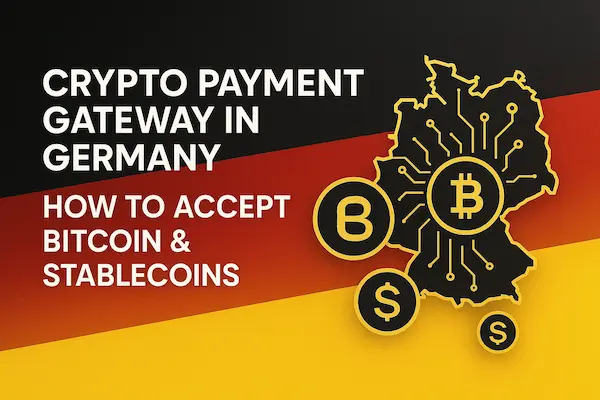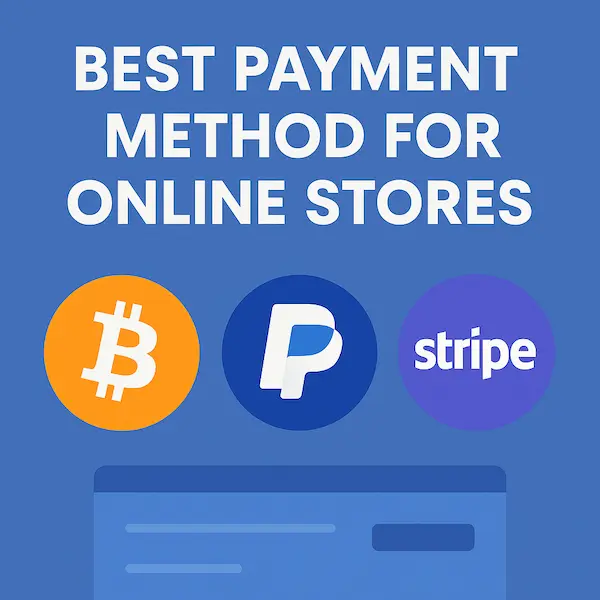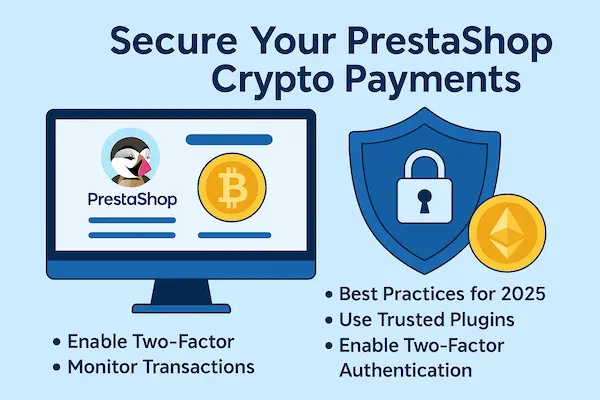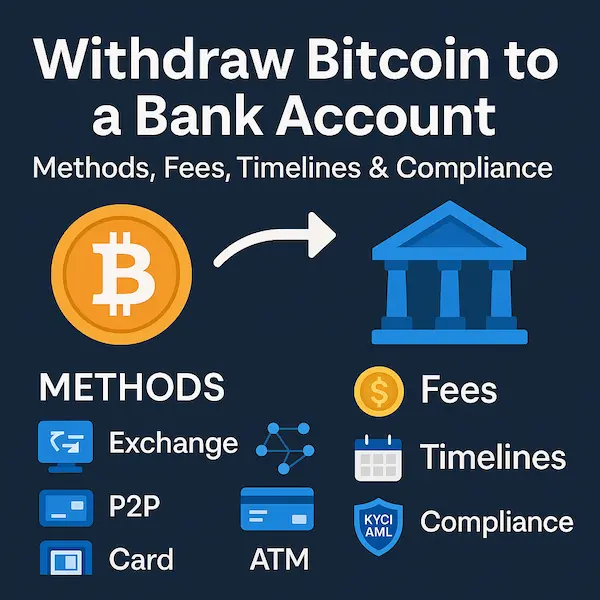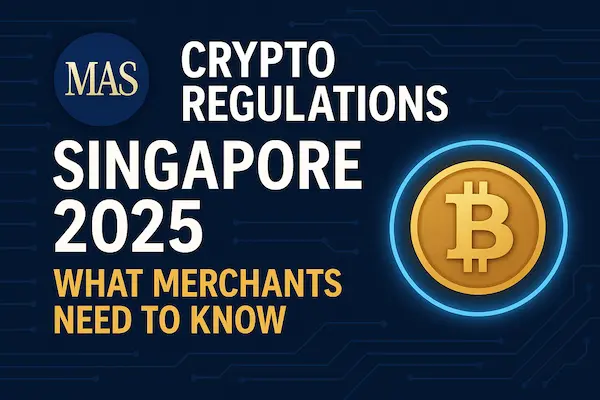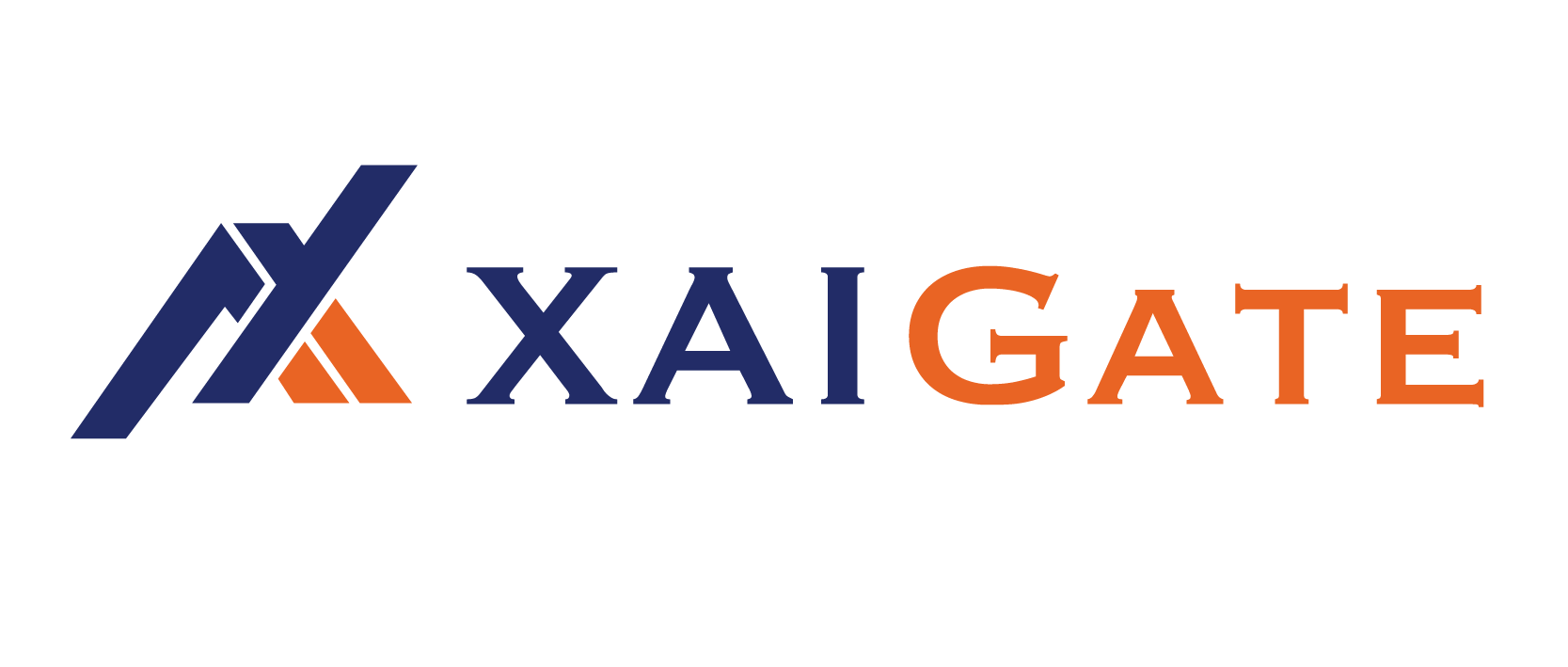A crypto payment gateway in Germany enables merchants to accept digital assets—like BTC, ETH, and euro-stablecoins—online or in-store and settle in either crypto or euros. The best options combine MiCA-aligned compliance, BaFin-aware controls, EU AML/KYC, PSD2-style security, and clean accounting exports. German businesses typically compare gateways on fees, settlement speed (EUR T+0/T+1), custody model, reporting quality, plugin support (Shopify/WooCommerce), and hands-on support.
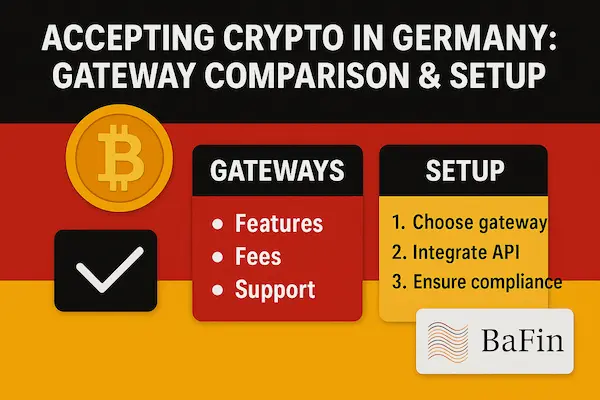
Contents
- 1 1. Introduction: Why this matters now
- 2 2. Germany & EU Regulatory Snapshot for 2026
- 3 3. Why German merchants are adding crypto payments
- 4 4. How Crypto Payments Work in a German Checkout
- 5 5. How to Choose the Right Crypto Payment Gateway in Germany
- 6 6. Costs, Margins & ROI
- 7 6. Legal, VAT & Data Protection Essentials (Germany/EU)
- 8 7. German Merchant Use Cases: Real-World Rollouts
- 9 8. 2026 Outlook: What German Merchants Should Expect
- 10 FAQs for Best Crypto payment gateway in Germary for Merchants (2026)
- 11 Conclusion, Newsworthy Takeaways & Next Steps (2026)
- 12 Make It Real: Switch On Crypto Payments in Germany with XaiGate
1. Introduction: Why this matters now
German commerce is at a crossroads. Cards and bank transfers still dominate, but international buyers increasingly expect crypto at checkout—especially in software, gaming, collectibles, and high-AOV cross-border orders. A compliant, production-ready Crypto Payment Gateway in Germany lets you meet that demand without turning your finance team into blockchain engineers: customers pay in BTC/ETH/stablecoins, you settle predictably in EUR via SEPA, and reconciliation lands cleanly in your ERP.
Three shifts make this moment different from the last crypto cycle:
- Regulatory clarity → business confidence. With EU-level rules in force and BaFin’s well-established supervision, the question has moved from “Is this allowed?” to “Which controls, reports, and data flows do we need?” Mature gateways now ship the KYC/AML, audit trails, and payout governance that risk teams expect.
- Operational maturity → lower lift. Off-the-shelf plugins for Shopify and WooCommerce, stablecoin rails that minimize price swings, Lightning for instant BTC, and auto-conversion to EUR mean faster launches and simpler accounting. Refunds, partials, and invoice workflows are no longer edge cases—they’re productized.
- Checkout economics → measurable upside. Crypto Payment Gateway in Germany can trim dispute loss (no card-style chargebacks), reduce cross-border friction, and open new segments that abandon when cards fail. For finance, instant conversion locks rates at payment time; for ops, exports map TX IDs to order IDs so month-end closes don’t slip.
2. Germany & EU Regulatory Snapshot for 2026
Why this matters. For a merchant evaluating a Crypto Payment Gateway in Germany, regulation isn’t paperwork—it’s the difference between smooth audits and nasty surprises. In 2026, MiCA shapes how European providers handle issuance, custody, and crypto-asset services, while German expectations around AML/KYC, data protection, and consumer rights keep day-to-day operations disciplined.
MiCA in plain language. MiCA sets common EU rules for crypto-asset service providers (CASPs). For you, that means reputable gateways document who they serve, how they safeguard funds, and how they disclose risks and fees. You shouldn’t need to be a lawyer: look for clear terms, transparent pricing, and predictable settlement policies. When a gateway says it’s “MiCA-aligned,” expect practical things—sanctions screening, audit trails, incident reporting, and customer disclosures you can actually hand to your compliance team.
BaFin-aware operations. Germany’s supervisor is known for rigor. A mature provider understands German expectations even if it operates across the EU—think robust onboarding, proper handling of custody (if offered), and clean separation between payment processing and merchant funds. As a rule of thumb: if a provider can explain—in one page—how it meets German AML/KYC standards, you’re on the right track.
AML/KYC & the Travel Rule. Gateways verify your business, monitor transactions for red flags, and exchange sender/receiver details when required. Practically, this shows up as a sensible onboarding checklist, automated checks in the background, and clear guidance for edge cases (e.g., large B2B invoices paid in stablecoins).
PSD2/SCA parallels. Crypto isn’t card, but German buyers expect familiar safeguards. Leading gateways mirror PSD2-style security with device checks, velocity rules, and risk signals that stop obvious fraud without slowing honest customers.
Accounting, VAT & record-keeping. Your finance team needs reliable exports: invoice IDs, asset/fiat rates at the quote moment, settlement amounts, and fees split out. The right crypto payment gateway gives you reconciliation that plugs into your ERP, plus documentation so your tax advisor can categorize revenue and refunds cleanly.
Data & consumer protection. GDPR hygiene still matters: keep customer data minimal, documented, and retrievable. Refunds and returns should be spelled out—especially if you quote in euros but accept crypto. Clear policies reduce support tickets and build trust.
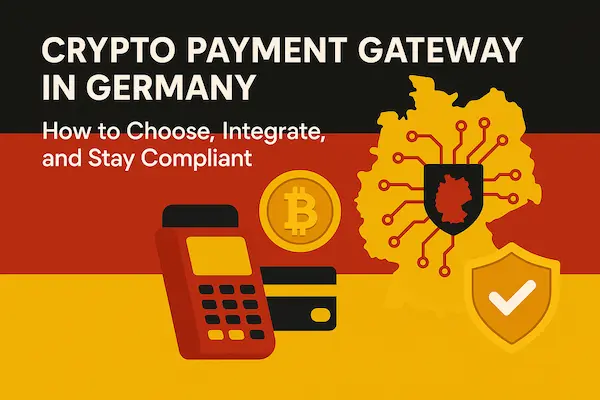
3. Why German merchants are adding crypto payments
For German retailers and B2B exporters, adding a Crypto Payment Gateway in Germany is no longer a novelty play—it’s an operational lever for revenue, cost control, and market access. Below are the business-grade reasons teams advance this initiative, with the nuts-and-bolts implications for product, finance, and risk.
1.1 Demand you can’t reach with cards alone
- Crypto-native buyers & power users: Tech, gaming, collectibles, and Web3 audiences often keep value in BTC/ETH/stablecoins. Offering their preferred tender type lifts checkout completion without discounting.
- Card-failure geographies: In certain markets, cards underperform or fail 3-D Secure. Crypto provides a push-payment path that doesn’t rely on local card acceptance.
- B2B cross-border invoices: For software/licensing and services, crypto can shorten time-to-cash compared with patchy correspondent banking routes.
1.2 Checkout economics that are actually measurable
- Lower dispute drag: Crypto is push-only, so you eliminate classic card chargebacks (you still need a clear refund workflow).
- Predictable FX at payment time: With auto-conversion, the rate is locked as the buyer pays, aligning revenue recognition with finance calendar closes.
- Fee structure you can model: Gateway % + FX spread is straightforward; on mid-to-high AOV, the effective take rate can be competitive with premium card tiers.
1.3 Operational maturity: from “experimental” to productized
- Plugins that ship, not demos: Shopify/WooCommerce apps + tested webhooks reduce engineering lift to configuration, not custom builds.
- Stablecoins and Lightning as first-class citizens: Stablecoins damp volatility; Lightning improves BTC speed and cost—both now have production-grade monitoring and retry logic.
- Refunds as a solved path: Good Crypto Payment Gateway in Germany support partial refunds, buyer notifications, and audit trails—so CS doesn’t become a bespoke crypto desk.
1.4 Brand and acquisition effects you can point to
- Trust & transparency signals: A public help-center article (“How to pay with crypto”), visible refund policy, and clear payout timelines are crawled, indexed, and often quoted by answer engines.
- SERP coverage for intent queries: Pages that explicitly address “accept crypto in Germany,” “EUR settlement,” and “invoice with crypto” tend to capture long-tail, bottom-funnel demand.
- Merchandising moments: PDP badges (“Pay with Bitcoin & stablecoins. EUR settlement.”) lift micro-conversion without touching pricing.
1.5 Risk, compliance, and data that satisfy internal stakeholders
- KYC/AML built into the vendor: Merchant onboarding, monitoring, and suspicious-activity processes move to your gateway partner’s domain, with documented controls.
- Data protection & auditability: EU data residency options, retention windows, and exportable logs (CSV/API/SFTP) let you pass security reviews and tax audits.
- Separation of duties: Product owns UX; Finance owns settlement/reconciliation; Security/Risk signs off on provider controls—a clean RACI, not a science project.
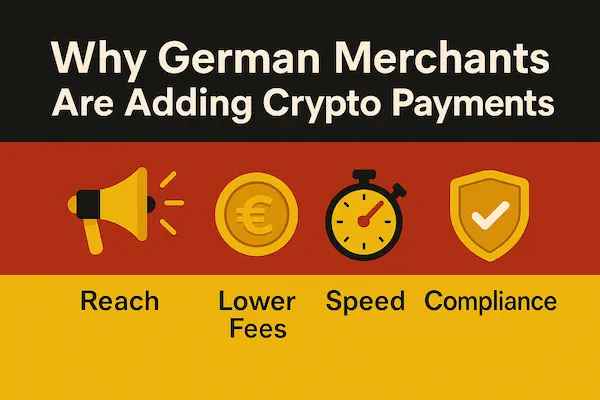
Top 5 Crypto Payment Gateways for Germany (Comparison)
| # | Provider | Model | EUR / Payout Options | Integrations & Notes | Best For |
|---|---|---|---|---|---|
| 1 | XaiGate | Custodial / hybrid | Advertises instant/global processing; merchant-oriented settlement and stablecoin flows (verify during onboarding). | Positioning: enterprise-ready gateway; multiple assets; business-focused onboarding. | Fast pilot, low fees, euro-first ops, clear dashboards. |
| 2 | BitPay | Custodial | EUR settlement via SEPA; daily payouts; split crypto/fiat supported. | Mature plugins/APIs; broad merchant tooling. | SMB→enterprise wanting predictable SEPA EUR payouts. |
| 3 | CoinGate | Custodial | Configure EUR settlement (“Receive Currency” = EUR); supports instant/stablecoin payouts narrative. | Popular ecommerce plugins; payouts/settlements docs. | Stores needing flexible receive currency and stablecoin options. |
| 4 | CoinPayments | Custodial (with partners) | Fiat settlement to EURO via Coinmotion integration. | Long-running processor; broad coin coverage. | Merchants prioritizing many assets + EUR conversion. |
| 5 | BTCPay Server | Non-custodial, self-hosted | You control wallets; EUR comes via your own conversion/PSP/OTC flow (no built-in fiat). | Open-source, censorship-resistant; Germany-friendly community docs. | Technical teams wanting maximum control, low fees, no third-party custody. |
4. How Crypto Payments Work in a German Checkout
If you’re evaluating a Crypto Payment Gateway in Germany, choose one that behaves like a modern PSP—predictable quotes, quick confirmations, clean EUR settlement, and audit-ready exports. As a pragmatic first step, you can pilot with XaiGate to validate these flows before scaling.
1. End-to-End Flow (What Actually Happens)
A shopper selects “Pay with crypto.” The gateway generates a euro quote, displays a QR/deep link, monitors the chosen network, and marks the order Paid after confirmation. You choose EUR (SEPA Instant/T+0–T+1), crypto, or split settlement. Finance sees reconciled payouts; ops get reliable webhooks and clear order states.
2. Price Quotes & Rate Locks (No Surprises)
Use time-boxed quotes (e.g., 60–300s) showing both the euro total and the crypto equivalent. Lock spreads/fees during the window, log timestamp and price source, and re-quote gently if time expires so booked amounts match paid amounts.
3. Network Choices: L1, L2 & Off-Chain
- L1 (on-chain): strong finality, variable fees/latency.
- L2: low fees, fast UX; ensure robust reorg handling and bridge hygiene.
- Off-chain accounts: instant UX for repeat users; rely on solvency/audits.
Retail flows favor L2; high-value B2B often prefers L1 for auditability.
4. Stablecoins (EUR & USD) Without Volatility
Stabilize pricing by accepting reputable, MiCA-aligned stablecoins. Enable auto-convert to EUR at quote time, and store the reference FX rate and tx hash on the invoice to keep accounting tight.
5. Custody Models (Know Your Trade-offs)
- Custodial: simpler ops; provider batches/settles.
- Non-custodial: more control/complexity.
- Hybrid: non-custodial pay-ins with instant EUR conversion.
Document which model you use and map it to BaFin-aware controls.
6. Settlement & Treasury Settings
Offer EUR settlement (SEPA Instant/T+0–T+1), crypto settlement (whitelisted corporate wallets), or split (e.g., 80% EUR / 20% crypto). Define payout schedules, approvers, and bank remittance references for smooth reconciliation.
7. Refunds & Disputes (No Card-Style Chargebacks)
Set clear rules for refund asset/path (original asset vs. EUR credit), rate basis (original euro amount vs. crypto paid), and fraud checks (e.g., proof-of-delivery). Publish the policy on checkout and invoices.
8. Invoicing & Reconciliation (Make Finance Happy)
Implement Invoice ID ↔ tx hash ↔ order ID tri-linking, show fee/spread breakdowns, and export CSV/JSON shaped to your ERP. Include refund/write-off codes and monthly VAT support files.
9. AML/KYC & Travel Rule (Operational, Not Theoretical)
Expect streamlined KYB, automated sanctions screening, and threshold-based Travel Rule exchanges. Use risk flags (mixer proximity, velocity anomalies) and maintain evidence trails suitable for audits.
10. Checkout UX That Converts
Offer but don’t force crypto. Provide QR + deep link, clear progress states (“Waiting → Confirming → Paid”), gentle timeouts with one-tap re-quote, and receipts that embed payment metadata and support links.
11. Performance & SLAs (Hold Providers Accountable)
Track quote acceptance, time-to-confirmation, success by network, refund latency, payout punctuality. Require 99.9%+ uptime, a public status page, signed webhooks with retries, and idempotency to prevent duplicate orders.
12. Edge Cases (Plan Before Go-Live)
Handle under/over-payments (auto top-up or auto-refund), stale quotes (soft expire + re-quote), network congestion (offer alternate networks), and address rotation to protect privacy.
13. In-Store & POS (Beyond eCommerce)
For physical retail, use POS terminals or cashier-screen QR with short amount locks and instant visual confirms. Plan offline fallbacks with delayed posting for intermittent connectivity.
14. Developer Paths (Plugins & API)
Fast path: Shopify/Woo/Magento plugins. Custom path: API flow—create quote → present request → subscribe/poll → fulfill → settle. Provide sandbox wallets and documented test vectors for QA.
15. Security, Webhooks & Minimal Data
Verify signed webhooks, use idempotency tokens, store minimal PII (invoice ID, tx hash, quote rate), rotate keys, and apply least privilege on API credentials.
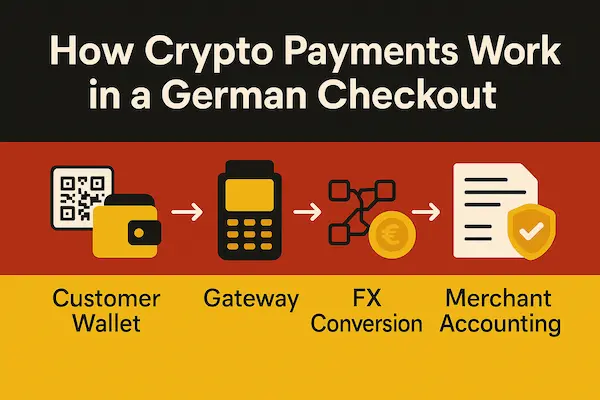
5. How to Choose the Right Crypto Payment Gateway in Germany
Picking a crypto payment gateway in Germany should feel like selecting a modern PSP: clear pricing, dependable euro settlement, and audit-ready data. Use this practical, merchant-first process to reach a short list you can pilot—without guesswork.
- Define your success metrics: Decide what “good” looks like in numbers: conversion lift, total cost per order vs. cards, time-to-confirmation, payout punctuality (T+0/T+1), refund latency, and monthly finance hours saved. Write these KPIs down before talking to vendors.
- Map your checkout & channels: List where you’ll accept crypto: web (Shopify/Woo/Headless), apps, or in-store POS. Confirm the gateway has first-party plugins or a clean API + webhooks, and supports both an L2 (for speed/fees) and at least one L1 (for high-value B2B finality).
- Verify compliance & German context: Ask for a one-pager explaining MiCA alignment, AML/KYC, sanctions screening, and Travel Rule handling. Ensure the custody model (custodial/non-custodial/hybrid) is explicit and BaFin-aware. You don’t need a thesis—just operational clarity you can show to auditors.
- Demand predictable euro settlement: Confirm EUR payouts via SEPA/SEPA Instant, cadence (daily T+0/T+1), remittance references, and any fees for instant rails. If you’ll accept stablecoins, require auto-convert to EUR at quote time to neutralize volatility unless treasury wants crypto on balance sheet.
- Insist on transparent quotes & logging: Quotes should be time-boxed (e.g., 60–300s) and show euro total + crypto equivalent. The gateway must log price source, timestamp, spread/fees, and the transaction hash tied to the invoice and order ID for reconciliation.
- Compare total cost of ownership—not just % fees
Model 3 baskets (€50 / €200 / €1,000). Include processor fee + spread, network fees, payout/FX, refund overhead, and the value of fewer chargebacks. Your target: equal or better net margin than cards with less back-office friction. - Check finance-grade exports: Look for invoice ↔ tx hash ↔ order ID tri-linking, fee/spread breakdowns, ERP-ready CSV/JSON, refund/write-off codes, and monthly VAT packs. If your finance team can’t close the books easily, keep shopping.
- Test real-world reliability: Require 99.9%+ uptime, a public status page, signed webhooks with retries, idempotency keys, and clear incident comms. In a 2–4 week pilot, track: quote acceptance rate, confirmation time, success by network, payout punctuality, and refund latency.
- Write the edge-case playbook: Before go-live, standardize flows for under/over-payments, expired quotes, network congestion (offer an alternate network), and address rotation for privacy. Publish a plain-English refund policy on checkout and invoices.
- Contract what vendors promise: Translate marketing into terms: supported assets/networks, EUR payout cadence, fees/spreads, uptime SLOs, data retention, and export formats. Add a quarterly review clause so you can swap networks or fee tiers as volumes grow.
The right Crypto Payment Gateway in Germany is the one that proves—through a measured pilot—that it can boost conversion or margins while keeping your books, compliance, and customer experience clean.
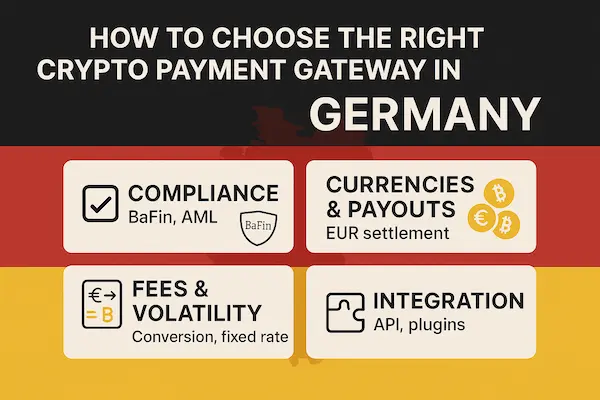
6. Costs, Margins & ROI
When you compare card rails to a Crypto Payment Gateway in Germany, look beyond headline processing fees. Total cost = network fee + processor fee/spread + payout/FX + ops time around refunds and reconciliation. Your goal is simple: equal or better net margin at stable conversion, without adding back-office friction.
1. What actually drives cost
- Processing & spread: Some gateways price per-transaction plus a small FX/spread on conversion to EUR. Ask for a blended quote.
- Network fees: Highly variable; L2s are usually cents, L1 can spike. Use L2 for low AOV carts.
- Payout cadence: Daily T+0/T+1 is friendlier for cash flow; confirm any fees for SEPA Instant.
- Refund overhead: Even without chargebacks, staff time + network fees exist; script the flow to cut tickets.
2. Sample basket math (illustrative)
- €50 AOV, L2 path: network ~near-zero, processor 0.8–1.5% → cost ≈ €0.40–€0.75; cards at 1.5–2.5% + €0.10 → €0.85–€1.35.
- €200 AOV, L2 or efficient L1: crypto cost ≈ €1.6–€3.0; cards ≈ €3.1–€5.1.
- €1,000 AOV, invoice-style: crypto ≈ €8–€15; cards ≈ €15–€25 (+ higher dispute exposure).
(Run your own pilot because fees and routes vary.)
3. Where savings usually appear
- Chargeback exposure: Crypto has no card-style chargebacks; you reduce losses and admin time.
- Cross-border & FX: Stablecoin acceptance + EUR conversion often beats card FX on non-EUR customers.
- Ops time: Clean exports (invoice ↔ tx hash ↔ order) can save hours per month in finance.
4. ROI levers you control
- Default to euro-stablecoin quoting for price clarity; auto-convert to EUR if volatility bothers finance.
- Route small carts on L2; reserve L1 for high-value, audit-heavy B2B.
- Publish a plain-English refund policy to shrink support load.
- Track quote acceptance rate and time-to-confirmation; tune network defaults accordingly.
6. Legal, VAT & Data Protection Essentials (Germany/EU)
When you roll out a Crypto Payment Gateway in Germany, treat legal, tax, and privacy as first-class workstreams—planned up front, not patched later. The points below are practical guardrails, not legal advice; confirm details with your counsel and tax advisor before go-live.
1. Licensing & scope (merchant vs. gateway)
Most merchants accepting crypto via a third-party gateway don’t themselves perform regulated custody or exchange services. Still, confirm your exact flow (custody, conversion, settlement) so counsel can document why no BaFin license is required for your role, and which obligations fall on the gateway.
2. Terms, disclosures & checkout language
Update T&Cs and checkout copy to cover: quote windows (price validity), supported assets/networks, refund rules (asset vs. EUR), dispute process, and customer support channels. Keep wording plain-English and mirror it on invoices.
3. AML/KYC & Travel Rule readiness
Expect KYB (company docs, UBOs) and ongoing AML monitoring from your provider. Clarify when Travel Rule information exchange triggers, how it’s transmitted, and what evidence you’ll retain for audits. Document sanctions-screening responsibilities on both sides.
4. Invoicing & revenue recognition
Your invoice should capture: order ID, asset, on-chain tx hash, euro amount, reference FX rate at quote time, fees/spreads, and net proceeds. Agree with finance on when revenue is recognized (e.g., after confirmation) and how cancellations/expired quotes are booked.
5. VAT treatment (principles to align on)
VAT generally follows the underlying goods/services, not the payment rail. Define: invoice format, VAT rates, how credit notes are issued for refunds, and how exchange differences (if any) are handled. Align with your advisor on cross-border supplies and evidence needed for zero-rating/exports.
6. Recordkeeping & audit trails
Maintain a coherent chain: invoice ↔ order ↔ tx hash ↔ payout batch. Keep pricing logs (source, timestamp, spread), sanctions/AML evidence, and settlement remittances for the statutory retention period applicable to your business records.
7. Consumer rights & refunds
If you sell to consumers, ensure your crypto refund policy respects applicable consumer protection rules (e.g., withdrawal rights where relevant) and is technically enforceable: define refund asset, rate basis (original EUR vs. crypto paid), and processing times in business days.
8. GDPR fundamentals (privacy by design)
Identify a lawful basis for processing, practice data minimization (store invoice/tx metadata, not full wallet histories), and update your privacy notice. Put a Data Processing Agreement (DPA) in place with the gateway, assess data-transfer mechanisms (e.g., SCCs) if data leaves the EEA, and consider a DPIA if you do behavioral monitoring or large-scale profiling.
9. Security, access & incident handling
Enforce role-based access, key rotation, webhook signing, encryption in transit/at rest, and least privilege for API credentials. Define incident-response RACI with the provider (who notifies whom, within what timeframe, with what artifacts) and keep an auditable change log.
10. Cross-border payouts & treasury controls
Document how EUR hits your account (SEPA/SEPA Instant), who approves payouts, and how you reconcile foreign-currency legs if you ever settle partially in Crypto Payment Gateway in Germany. Specify how you’ll evidence beneficial ownership for whitelisted corporate wallets.
7. German Merchant Use Cases: Real-World Rollouts
1. Berlin D2C Electronics — Faster Checkout, Lower Fees
Profile: €18M GMV Shopify store shipping across the EU; high cross-border mix.
Problem: Card declines on non-EU BINs and rising dispute costs.
Approach: Piloted a Crypto Payment Gateway in Germany on one storefront, enabling BTC/ETH + one L2 and euro-stablecoins with auto-convert to EUR. Quotes locked for 180s; EUR payouts on SEPA T+1.
Results (8 weeks):
- +2.4% absolute lift in overall checkout conversion (crypto chosen by 6.8% of paying users).
- −41% blended payment cost on crypto orders vs. cards (AOV €210).
- T+1 EUR payout punctuality 99.3%; reconciliation time −55% thanks to invoice ↔ tx hash ↔ order linking.
What made it work: L2 default for baskets <€250, clear refund policy (EUR credit or same-asset), and ERP-ready exports.
2. Munich B2B SaaS — Stablecoin Invoicing, Cleaner Cash Flow
Profile: €32M ARR, invoicing mid-market clients in 17 countries; Net 15/30 terms.
Problem: FX friction, late wires, and manual matching of SWIFT references.
Approach: Offered stablecoin → EUR at quote time on invoices; whitelisted client billing contacts; required business identifiers for Travel Rule thresholds. Payouts batched daily into EUR via SEPA Instant where supported.
Results (quarter):
- DSO improved from 28.7 → 21.9 days for crypto-enabled accounts.
- Payment ops time −46% (automatic remittance refs matched to invoice IDs).
- Zero chargebacks; refund SLA cut from 6→3 business days.
What made it work: Stablecoin default for non-EUR clients, strict quote windows, and finance sign-off on VAT/credit-note handling before go-live.
3. Hamburg Hospitality & Events — POS + Online, One Reconciliation
Profile: Group with 5 venues and an events business; mixed POS/e-commerce flows.
Problem: Night-of-event network congestion risk and fragmented reporting across POS + web.
Approach: Deployed L2 at POS with amount locks (120s) and offline fallback; online store used the same gateway/API for unified exports. Split settlement 80% EUR / 20% crypto for treasury testing.
Results (season):
- Crypto Payment Gateway in Germany used by 4.2% of guests but drove +1.1% venue-wide revenue via higher ticket add-ons.
- End-of-month close time −38% with a single payout → batch → order export.
- No abandoned carts from expired quotes after moving L2 to default.
What made it work: Clear cashier prompts, visible status states (“Waiting → Confirming → Paid”), and weekly KPI reviews (quote acceptance, confirmation time, payout punctuality).
8. 2026 Outlook: What German Merchants Should Expect
2026 is the year crypto payments stop being “special” and start behaving like any other rail in German commerce. With MiCA fully bedded in, faster L2 networks, and euro-first settlement paths, the Crypto Payment Gateway in Germany story turns from hype to housekeeping: predictable cash flow, cleaner books, and clearer rules.
1. Regulation gets practical, not louder: MiCA operational routines—attestations, Travel Rule automation, and incident playbooks—become table stakes. Vendors compete on how little work they create for your finance and compliance teams.
2. Euro-stablecoins go mainstream: More invoices quote in EUR (stablecoin under the hood) with auto-convert to euros at quote time. Expect shorter cash cycles and easier VAT evidence as rate logging becomes standardized.
3. L2 becomes the retail default: Low fees and near-instant confirmations push L2 to the front for carts <€250, while L1 remains the B2B choice where auditability/finality matters.
4. SEPA Instant spreads—cash flow tightens: Same-day EUR settlement expands across banks; payout cut-offs and remittance references get cleaner. Treasury gets predictable T+0/T+1 without heroic workarounds.
5. ERP-grade integrations win deals: Gateways differentiate on exports: invoice ↔ order ↔ tx-hash tri-linking, monthly VAT packs, refund/write-off codes, and native connectors. “Close the month in hours, not days” becomes a credible claim to verify in pilots.
6. Refunds become boring (by design): Clear policies (asset vs. EUR, rate basis, SLA) and prebuilt flows reduce tickets. No card-style chargebacks remains an advantage—paired with better proof-of-delivery checks.
7. POS catches up to web: Static QR and L2 “tap-to-pay-style” pilots move from trials to production for events and hospitality, using short amount locks and offline fallbacks.
8. Quarterly optimization is standar: Merchants renegotiate spreads, retire underperforming networks, and tune routing (L2 vs. L1) by AOV. Payment mix becomes a margin lever you actively manage—not a set-and-forget toggle.
FAQs for Best Crypto payment gateway in Germary for Merchants (2026)
1. Is accepting crypto legal for merchants in Germany?
Yes. German businesses may accept crypto via a compliant gateway. Ensure MiCA-aligned operations, AML/KYC, sanctions screening, clear disclosures, and audit-ready records. Treat crypto as a payment rail; consumer and tax rules still apply.
2. Do I need a BaFin license to accept crypto payments?
Typically no. Using a third-party processor for checkout does not make a merchant a custodian or exchange. Confirm your exact flow (custody, conversion, settlement) with counsel and your Crypto Payment Gateway in Germany.
3. How should VAT and invoices be handled for crypto sales?
VAT follows the underlying goods/services. Invoices should show EUR amount, reference FX rate at quote time, fees/spreads, and the tx hash linked to the order. Use ERP-ready exports and credit notes for refunds.
4. How do refunds and “chargebacks” work with crypto?
There are no card-style chargebacks. Define refund asset/path (original asset or EUR credit), the rate basis (EUR or crypto at purchase), and SLAs. Require proof-of-delivery checks to deter abuse.
5. Which assets and networks should I enable in 2026?
Enable BTC/ETH plus one fast L2 for retail and at least one L1 for high-value B2B. Include reputable euro/USD stablecoins with auto-convert to EUR to minimize volatility and simplify accounting.
6. How do AML/KYC and the Travel Rule impact merchants?
Gateways handle KYB onboarding and screen transactions. Above thresholds, sender/receiver info may be exchanged under the Travel Rule. Keep evidence trails (pricing logs, tx metadata, sanctions checks) for audits.
7. Can I settle to euros the same day (SEPA/SEPA Instant)?
Often yes. Choose a provider offering EUR settlement via SEPA/SEPA Instant with T+0/T+1 cadence. Verify cut-off times, instant-rail fees, remittance references, and reconciliation exports before go-live.
8. What’s the best way to reconcile crypto payments?
Tri-link invoice ↔ order ↔ tx hash, then match payout batches to bank entries. Log price source/timestamp/spread, store refund/write-off codes, and generate monthly VAT packs. Automate checks where possible.
Conclusion, Newsworthy Takeaways & Next Steps (2026)
Germany enters 2026 with clearer EU rules, better L2 rails, and euro-first settlement options—exactly the mix merchants needed to treat crypto like any other payment rail. If your team can prove lower total cost per order, same-day EUR settlement, and clean books, a Crypto Payment Gateway in Germany stops being a side experiment and starts pulling its weight next to cards and PayPal. The play is simple: run a focused pilot on one L2 + one L1, lock quotes in EUR, and measure conversion, cost, and ops time with finance in the loop.
Quick Summary
| Decision Area | What “Good” Looks Like | Action You Can Take This Month |
|---|---|---|
| Compliance & German context | MiCA-aligned ops, KYB done, Travel Rule workflow documented, BaFin-aware custody stance | Request a one-pager + recent attestations; add to your audit kit |
| EUR settlement | SEPA/SEPA Instant, T+0/T+1, remittance refs in exports | Pilot with EUR auto-convert at quote time; confirm payout cut-offs |
| Costs & margin | Equal/better net margin vs. cards on €50/€200/€1,000 baskets | Model baskets; route small AOV to L2; track actuals weekly |
| UX & conversions | Quote window 60–300s, QR + deep link, clear states (“Waiting → Confirming → Paid”) | A/B test tooltip and placement; monitor quote acceptance rate |
| Finance & VAT | Invoice ↔ order ↔ tx hash linking; ERP CSV/JSON; VAT packs | Dry-run month-end close using sandbox exports |
| Reliability | 99.9%+ uptime, signed webhooks, retries, idempotency | Add status page + webhook signature checks to your runbook |
| Refunds & disputes | Plain-English policy; asset/EUR path defined; proof-of-delivery checks | Publish policy on checkout + invoices; train support with macros |
| Scale & review | Quarterly fee review, asset/network re-evaluation | Calendar a QBR; keep an exit path to avoid vendor lock-in |
Why this is timely
- MiCA operationalization across the EU hardens provider practices and reduces ambiguity for merchants.
- Euro-oriented stablecoin flows + SEPA Instant shorten cash cycles.
- L2 throughput and fees support retail-grade UX—fewer abandoned carts, quicker confirmations.
These shifts make Crypto Payment Gateway in Germany a current, business-relevant story: lower dispute exposure, faster settlement, and cleaner accounting—right now, not “someday.”
Make It Real: Switch On Crypto Payments in Germany with XaiGate
Run a results-first pilot with XaiGate—a gateway built for German merchants who need euro-first settlement, clean books, and enterprise-grade controls.
Choose XaiGate as your Crypto Payment Gateway in Germany and launch a production pilot this month. Make crypto a dependable, revenue-positive option in your checkout—with euro cash flow your finance team can trust.
For daily updates, subscribe to XAIGATE’s blog!
We may also be found on GitHub, and X (@mxaigate)! Follow us!

